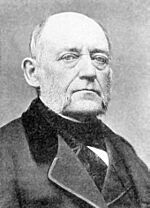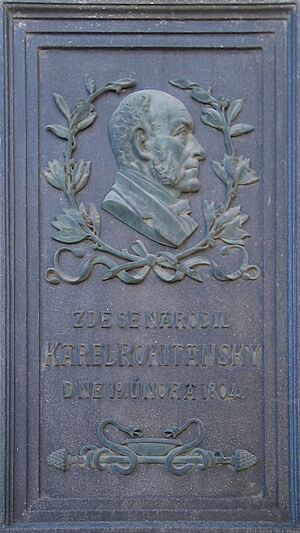Carl von Rokitansky facts for kids
Quick facts for kids
Baron Carl von Rokitansky
|
|
|---|---|

Baron Carl von Rokitansky
|
|
| Born | 19 February 1804 Hradec Králové (Königgrätz), Bohemia, Habsburg monarchy
|
| Died | 23 July 1878 (aged 74) |
| Alma mater | University of Vienna |
| Scientific career | |
| Fields | Physician pathologist |
Baron Carl von Rokitansky (born February 19, 1804 – died July 23, 1878) was an important Austrian doctor. He was a pathologist, which means he studied diseases by looking at how they affected the body. He was also a philosopher and a politician.
Carl von Rokitansky helped create the famous Viennese School of Medicine in the 1800s. He is known for starting a new way of diagnosing illnesses based on science.
Contents
Early Life and Education
Carl Joseph Wenzel Prokop Rokitansky was born in Hradec Králové, which was then part of the Habsburg monarchy. His family faced tough times after his father died early. But his mother made sure he could go to school.
Carl first wanted to study classic languages at Charles University in Prague. However, in 1821, he decided to study medicine instead. In 1824, he moved to Vienna to continue his medical studies at the University of Vienna.
In 1827, he started working at the Vienna General Hospital. He began doing autopsies, which are medical examinations of bodies after death. He earned his medical degree in 1828. His early work focused on smallpox vaccination.
Medical Career Highlights
Carl Rokitansky quickly became a key figure in medicine. In 1832, he became the temporary director of the Pathological-Anatomical department. By 1834, he was a professor of pathological anatomy at the University of Vienna.
In 1844, he became the first person to hold a full professorship in pathological anatomy in the German-speaking world. He also served as the Dean of the Medical Faculty several times. In 1852, he was chosen as the first freely elected rector (head) of the University of Vienna.
Revolutionizing Pathology
The New Viennese School
In the 1830s, Carl Rokitansky helped start the New Viennese School of medicine. This school used new scientific methods to understand diseases. It changed how doctors thought about health and illness.
Before Rokitansky, doctors often described illnesses based only on what they saw. They didn't always look for the deeper causes inside the body. They still believed in old ideas, like the "four humours" theory from ancient Greece. This theory said that illnesses came from an imbalance of four body fluids.
Rokitansky wanted to find real, science-based explanations for diseases. He believed that illnesses had a specific "anatomical seat," meaning they came from changes in certain body parts.
Advancements in Diagnostics
Rokitansky performed nearly 60,000 autopsies during his career. He carefully compared what doctors observed in patients when they were alive with what he found during the autopsies. He realized that many symptoms doctors saw were actually signs of changes happening inside the organs.
Working closely with other doctors, he showed how outward symptoms were connected to changes in organs. This is called "clinico-pathological correlation." For the first time, doctors could make truly scientific diagnoses. This was a huge step forward! It moved medicine from guesswork to a systematic, science-based approach.
Rokitansky also pushed for better care for patients with mental health issues. He believed they deserved proper diagnosis and treatment. His ideas helped pave the way for modern psychology.
His Famous Manual
Rokitansky wrote a three-volume book called Handbuch der pathologischen Anatomie (Manual of Pathological Anatomy). It was published between 1842 and 1846. In this book, he described how diseases affected every organ. He also explained how to diagnose illnesses based on symptoms and organ changes.
The book included detailed drawings of what he saw under the microscope. The Emperor even made it a required textbook for all medical students. Doctors and students from all over the world came to Vienna to learn his methods. His manual was translated into many languages, including Russian, English, Dutch, and Italian.
Understanding Blood and Illness
Rokitansky was very interested in how blood affects health. He studied blood, plasma, and other body fluids. He developed ideas about "crases and dyscrases," which were early thoughts on how problems with proteins and other blood components could cause illness.
His ideas were quite advanced for his time. Some doctors disagreed with him, but his work helped set the stage for modern understanding of how the immune system works. He also pushed for new research departments to study medical chemistry and experimental pathology.
Political and Philosophical Influence
Carl Rokitansky was also a strong supporter of Liberalism in Austria. He believed in freedom and progress, especially for science and education.
He argued that science should be free from political interference. He gave a famous speech in 1862 called "Freedom for Natural Science!" He believed that scientists should always remember that humans are "conscious and free-willing subjects," not just research objects. He emphasized the importance of compassion in medicine.
Rokitansky held important positions in government and academia. He advised the Ministry of the Interior on medical matters. He pushed for modern, interdisciplinary teaching at universities. He also worked to make sure all students had equal opportunities. Thanks to his efforts, some medical schools became full universities.
In 1867, Emperor Franz Joseph I appointed him to the upper house of the Reichsrat (parliament). There, he continued to advocate for educational reforms. He believed that different religious groups should have the right to open schools for their children.
He also helped improve public health. As president of the College of Physicians in Vienna, he supported building pipelines to bring fresh water to the city. He was also president of the Imperial Academy of Sciences, which he considered a great honor.
Family Life
In 1834, Rokitansky married Marie Weis, a talented concert singer. She had studied with the famous composer Antonio Salieri. Marie sang with other well-known musicians like Franz Schubert and Franz Liszt.
Carl and Marie had four sons. Two of them became famous musicians:
- Hans von Rokitansky (1835–1909), an opera singer.
- Victor von Rokitansky (1836–1896), a concert singer and composer.
Their two younger sons followed in their father's footsteps and studied medicine:
- Karl Rokitansky (1839–1898), became a professor of gynecology.
- Prokop Rokitansky (1842–1928), became a professor of internal medicine and a university rector.
Recognized Achievements
Rokitansky was honored by many scientific and medical groups around the world. He became a member or honorary member of academies and societies in Paris, Stockholm, London, New York, and other cities. He received several important awards and honorary diplomas for his contributions to science and medicine.
Medical Discoveries and Terms
Rokitansky's name is connected to several medical conditions and features of disease, showing his lasting impact:
- Superior Mesenteric Artery Syndrome
- Müllerian agenesis (also known as "Mayer-Rokitansky-Küster-Hauser syndrome")
- Rokitansky's diverticulum
- Rokitansky's triad (related to pulmonary stenosis)
- Rokitansky-Aschoff sinuses (found in the gallbladder)
- Rokitansky-Cushing ulcer
- Rokitansky nodule (related to certain types of tumors)
- He was also the first to describe endometriosis in 1860.
Rokitansky developed a special method for performing autopsies. It's said that he oversaw 70,000 autopsies and personally performed over 30,000 of them! That's an amazing number, showing his dedication to understanding diseases.
Images for kids





